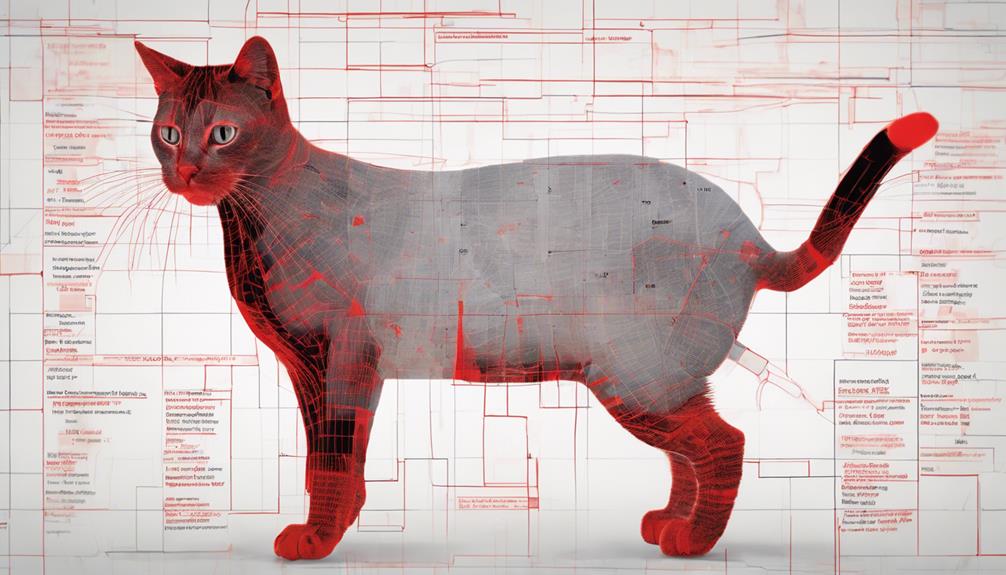15 Tips to Explore Cat Genetics and Behavior
If you're curious about cat genetics and behavior, diving into this topic is like unlocking a mysterious treasure chest. Understanding why your feline friend behaves the way they do can be as intriguing as deciphering a complex puzzle.
From the hues of their coats to the depths of their personalities, each whisker and purr tells a tale written in their genetic code.
So, are you ready to unravel the fascinating secrets behind your cat's genetics and behavior?
The Basics of Cat Genetics
Exploring the genetic makeup of cats provides insight into their physical characteristics and behavioral traits. Genetic mutations play a crucial role in shaping these attributes. Mutations can lead to unique coat patterns, eye colors, and even predispositions to certain health conditions. Understanding these genetic variations can help cat owners better care for their feline companions.
When it comes to breeding cats, it's important to be aware of the risks associated with inbreeding. Inbreeding occurs when closely related cats are bred together, increasing the chances of inherited genetic disorders. These disorders can range from mild to severe and may impact the overall health and wellbeing of the offspring. Responsible breeding practices aim to minimize the potential harm caused by inbreeding.
Understanding Coat Color Genetics
Understanding coat color genetics in cats provides valuable insights into the inheritance patterns of their fur coloring. By delving into the world of cat coat color genetics, you can uncover the fascinating mechanisms behind why your feline friend has a specific color pattern. When it comes to breeding strategies, knowledge of coat color genetics can be incredibly beneficial. Breeders can use this information to predict the potential coat colors of offspring, allowing them to plan matings that will produce desired colors or patterns.
Genetic testing is a powerful tool in understanding coat color genetics. Through genetic testing, breeders can determine the specific genes responsible for a cat's coat color. This knowledge can help breeders make informed decisions about which cats to breed together to achieve certain color outcomes. Additionally, genetic testing can be crucial in identifying hidden color genes that may not be visibly expressed but could be passed on to future generations.
Genetic Health Considerations for Cats
Delving into the genetic health considerations for cats sheds light on potential inherited conditions that may impact their well-being. Understanding the genetic makeup of your feline friend can help anticipate and manage any health implications they might face. Here are three key points to consider:
- Genetic Testing: Opting for genetic testing can provide valuable insights into your cat's predisposition to certain hereditary diseases. By identifying potential genetic markers early on, you can work with your veterinarian to establish preventive measures or early treatment plans, ultimately promoting your cat's overall well-being.
- Inherited Health Conditions: Cats can inherit various health conditions from their parents, ranging from heart diseases to kidney issues. Being aware of your cat's genetic predispositions can empower you to monitor their health closely and take proactive steps to mitigate the risks associated with these conditions.
- Health Implications: Genetic factors can significantly influence your cat's susceptibility to certain ailments. By understanding these genetic health considerations, you can tailor your cat's diet, exercise routine, and veterinary care to better address their specific needs and enhance their quality of life.
Exploring Cat Behavior Patterns
Uncover the intricate behaviors of your feline companion by observing their daily interactions and reactions. Cats are known for their unique personalities and behaviors, and by paying close attention, you can gain valuable insights into their world. To enhance your understanding and strengthen your bond with your cat, consider implementing socialization techniques and behavioral training. Socialization techniques involve exposing your cat to various experiences, people, and environments from a young age, helping them become more adaptable and comfortable in different situations. Behavioral training can also be beneficial in addressing specific issues or reinforcing positive behaviors.
In addition to socialization and training, environmental enrichment plays a crucial role in shaping your cat's behavior. Providing a stimulating environment with toys, scratching posts, and interactive play sessions can prevent boredom and help fulfill your cat's natural instincts. Play therapy is another effective way to engage with your cat and encourage healthy behaviors. Interactive toys, laser pointers, and puzzle feeders are great tools to keep your cat mentally and physically active.
Inherited Traits in Cat Breeds
Exploring the genetic makeup of different cat breeds reveals fascinating inherited traits that contribute to their distinct characteristics and behaviors. Understanding these hereditary characteristics can provide insights into why certain breeds exhibit specific physical features or behavioral tendencies.
Here are three key points to consider when delving into inherited traits in cat breeds:
- Breeding Standards: Cat breeds are developed based on specific breeding standards set by cat fancier associations. These standards outline the ideal physical characteristics for each breed, such as coat color, pattern, body shape, and eye color. Through selective breeding, breeders aim to maintain these standards from one generation to the next, resulting in the consistent appearance of a particular breed.
- Hereditary Characteristics: Certain hereditary characteristics are more common in specific cat breeds. For example, the Siamese breed is known for its striking blue almond-shaped eyes and distinctive color-point coat pattern. These traits are passed down from one generation to the next through genetic inheritance, highlighting the strong influence of genetics on a cat's appearance and behavior.
- Genetic Diversity: Despite the presence of breed standards, genetic diversity is essential to maintain overall feline health and well-being. Inbreeding to achieve specific traits can lead to genetic disorders and health issues. Responsible breeders aim to balance preserving breed characteristics with maintaining genetic diversity to ensure the long-term health of cat breeds.
Impact of Genetics on Cat Personality
Genetics play a significant role in shaping a cat's personality and demeanor. Genetic predispositions heavily influence a cat's behavior tendencies and overall temperament. Just like humans inherit certain traits from their parents, cats also receive personality traits through genetic influences.
Some cats may have a genetic predisposition towards being more outgoing and social, while others might lean towards being more reserved and independent. These personality traits can manifest in various ways, such as being affectionate, playful, or even aloof. Genetic influences can also determine how a cat responds to different stimuli, how they interact with their environment, and how they form bonds with their owners.
Understanding the impact of genetics on cat personality can help you better appreciate and cater to your feline friend's individual needs. For instance, if your cat has a genetic tendency towards being more curious and energetic, providing ample toys and opportunities for play can help satisfy these innate traits. On the other hand, if your cat is predisposed to being more laid-back and relaxed, creating cozy spots for them to lounge and relax can enhance their well-being.
Genetic Factors in Feline Aggression

Understanding how genetic factors contribute to feline aggression can provide valuable insights into managing and addressing this behavior in cats. Aggression in felines can stem from a combination of genetic predispositions and environmental factors.
Here are three key points to consider when looking at genetic factors in feline aggression:
- Aggression Triggers: Certain genetic traits in cats can make them more prone to react aggressively to specific stimuli. These triggers could vary from cat to cat, but understanding these genetic predispositions can help identify potential triggers and prevent aggressive outbursts.
- Behavior Modification: Genetic factors play a significant role in determining a cat's temperament and behavior patterns. Through behavior modification techniques such as positive reinforcement training, environmental enrichment, and socialization, it's possible to manage and reduce aggressive behaviors influenced by genetics.
- Genetic Counseling: In cases where feline aggression seems to have a strong genetic component, seeking guidance from a veterinarian or animal behavior specialist for genetic counseling can be beneficial. They can provide tailored advice on managing aggression in cats with specific genetic predispositions, offering strategies for behavior modification and creating a harmonious environment for your feline friend.
Breeding Practices and Genetic Diversity
How do breeding practices impact genetic diversity in cats?
Breeding ethics play a crucial role in maintaining genetic health and diversity in feline populations. When breeders prioritize genetic health, they're more likely to select mates based on diverse pedigrees rather than solely focusing on popular or trendy traits. By incorporating diversity in pedigrees, breeding practices can help reduce the prevalence of genetic disorders that arise from inbreeding.
It is essential for breeders to consider the long-term implications of their breeding practices on genetic diversity. By avoiding excessive inbreeding and promoting outcrossing, breeders can introduce new genetic material into cat populations, which can help enhance overall genetic health. Responsible breeders prioritize genetic diversity to ensure that future generations of cats are less susceptible to hereditary diseases and have a broader genetic resilience.
While it may be tempting to prioritize certain physical characteristics or traits in breeding programs, it's crucial to strike a balance between maintaining breed standards and preserving genetic diversity. Breeders who adhere to ethical breeding practices contribute to the sustainability of cat breeds and help safeguard against the negative consequences of limited genetic variation. By promoting genetic health and diversity, breeders play a vital role in ensuring the well-being of cats for generations to come.
Frequently Asked Questions
Can Cat Genetics Determine Their Likelihood of Developing Certain Health Issues?
Cat genetics play a significant role in determining their likelihood of developing certain health issues. Genetic predispositions can influence various health outcomes in cats. It's important to be aware of these genetic factors to provide appropriate care and early intervention if needed.
Regular vet check-ups and genetic testing can help in identifying potential health risks and managing them effectively. Understanding your cat's genetics can lead to a healthier and happier life for your feline friend.
How Do Environmental Factors Interact With Genetics to Influence a Cat's Behavior?
When it comes to your cat's behavior, environmental factors play a crucial role. Epigenetic influences can modify genetic predispositions, impacting behavioral traits. This dynamic interplay between nature and nurture shapes how your cat behaves.
Factors like socialization, diet, and living conditions can all influence your furry friend's actions. By understanding how genetics and environment interact, you can provide a supportive setting for your cat's well-being and happiness.
Are There Genetic Tests Available to Determine a Cat's Breed Mix?
Yes, there are genetic tests available to determine a cat's breed mix. These tests analyze your cat's DNA to provide insight into its breed identification and ancestry through genetic markers.
Can Genetic Traits Be Passed Down From a Cat's Parents to Their Offspring?
Genetic traits, like coat color and pattern, can definitely be passed down from a cat's parents to their offspring. Inherited behaviors and tendencies are also commonly observed in cats.
So, if your cat's parents had a specific coat color or certain behaviors, it's likely that these traits could be present in their kittens as well.
Genetics play a significant role in shaping both the physical and behavioral characteristics of cats.
How Do Genetics Play a Role in a Cat's Lifespan and Overall Health?
Genetics play a crucial role in your cat's lifespan and overall health. Lifespan factors and health are influenced by genetic diversity, affecting longevity.
Cats inherit various genetic traits from their parents, impacting susceptibility to diseases, immune system strength, and overall well-being. By understanding your cat's genetic makeup, you can make informed decisions about their care to promote a longer, healthier life.
Regular vet check-ups and a balanced diet can also contribute to your cat's well-being.
Conclusion
Now that you've delved into the world of cat genetics and behavior, you have a better understanding of why your feline friend is the way they are.
By learning about coat color genetics, genetic health considerations, behavior patterns, and inherited traits, you can provide the best care for your cat.
Remember, genetics play a significant role in shaping your cat's personality and behavior, so embrace their unique traits and characteristics.
